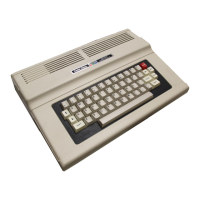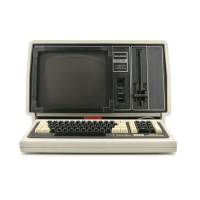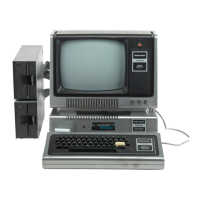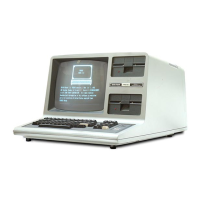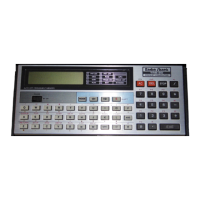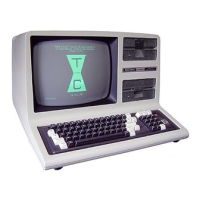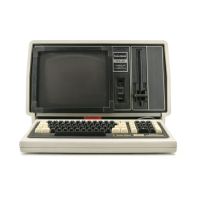port),
Z25, pin 6
will
output
a
low
generating
INSIG*
because
IN*
and
FF*
are
low.
IN*
and
OUT*
should never
be
active (low) at the
same
time. Thus, I
NSIG*
and
OUTSIG*
should never
be
active (low) at the
same
time.
OUTSIG*
The
OUTSIG*
line
is
used
to
control
two
cas-
sette
fu~ctions
and one video
function.
It
is
used
to
generate the audio signal
for
the Cassette
Recorder in a CSAVE
condition.
It
is
used
to
control
the Recorder's
motor
also. Its video
function
is
to
control
signal MOOESEL (Mode
Select). MOOESE L
will
change
64
character
format
to
32
character
format
or
vice versa.
OUTSIG*
is
also
controlling
a latch made up
of
NANO
gates in Z24.
We
will
discuss this
circuit
later.
Z59
is
a data latch controlled
by
OUTSIG*.
This
latch accepts data on lines
D0 through
03.
00
and 01
are
tied
to
pins 4 and 5
of
Z59. These
two
inputs
are
used
to
output
data
that
is
record-
ed
on tape during a CSAVE
function.
02
is
connected
to
pin 12
ofZ59.
This
input
controls
the
status
of
the Recorder's
motor.
D3
is
con-
nected
to
pin 13
of
Z59.
This
input
controls
the
status
of
MOOESEL
*.
The
input
to
latch
Z59
is
stored and transferred
to
the
output
each
time
OUTSIG*
goes
high
(rising
edge
triggered).
For
example,
if
input
02
is
high when
QUTSIG*
goes
high, pin
10
of
Z59
will
go
high and stay high. The Recorder's
motor
will
turn
on.
If
input
02
is
low
when
QUTSIG*
goes
high, pin 10
of
Z59
will
go
low
and the
Recorder's
motor
will
be
off.
Cassette
Motor Control
At
the start
of
a CSAVE
function,
the Cassette
Recorder
motor
must
be
turned on. The
CPU
will
cause
OUTSIG-*
to
go
low
and apply a logi-
cal
"1"
to
02.
When
OUTSIG*
goes
high, the
high on
02
will
be
transferred and held
at
pin
10
of
Z59. This
output
is
connected
to
relay drive
Z41, pins 1 and 2. Pin 3
of
Z41
will
go
low
caus-
ing
current
to
flow
through relay K1's coil. K1's
contacts close, shorting
out
pins 1 and 3
of
J3.
These
two
pins
are
associated
with
the remote
jack at the Recorder. The Recorder's
motor
will
then
turn
on.
Notice diode CR3 and Zeners CR9 and CR10.
CR3
is
a standard silicon diode
used
for
an
"anti-chatter"
function.
When power
is
applied
or
removed
from
K1's
coil,
a counter EM F
is
generated. This voltage could
be
high enough
to
damage Z41's
output
transistor
or
cause
K1
to
click
off
and on a couple
of
times resulting in
undue wear
of
the switching contacts.•CR3
will
shunt the counter EMF voltage around
K1
and
prevent transistor damage
or
relay chatter. Zener
diodes CR9 and
CR10
are
used
in somewhat the
same
way. Here we're
trying
to
protect
K1's
switch contacts. When the Recorder
is
turned
on, a high voltage spike could
be
produced,
resulting in
contact
arcing. CR9 and CR10 pre-
vent possible damage
by
shunting any voltage
spikes above a certain level away
from
the con-
tacts.
45
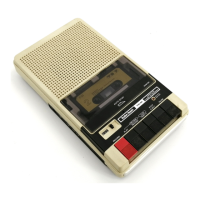
